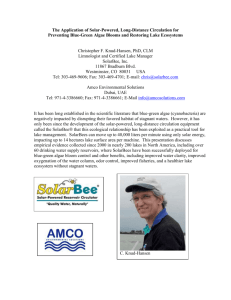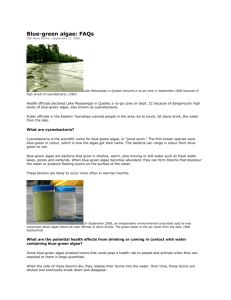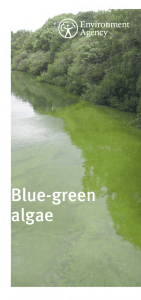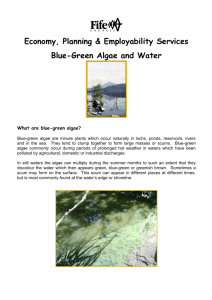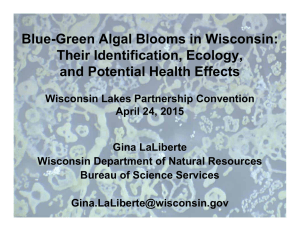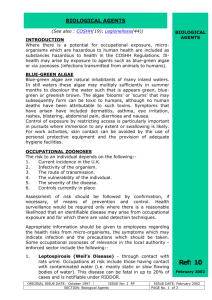Blue-green algae
advertisement
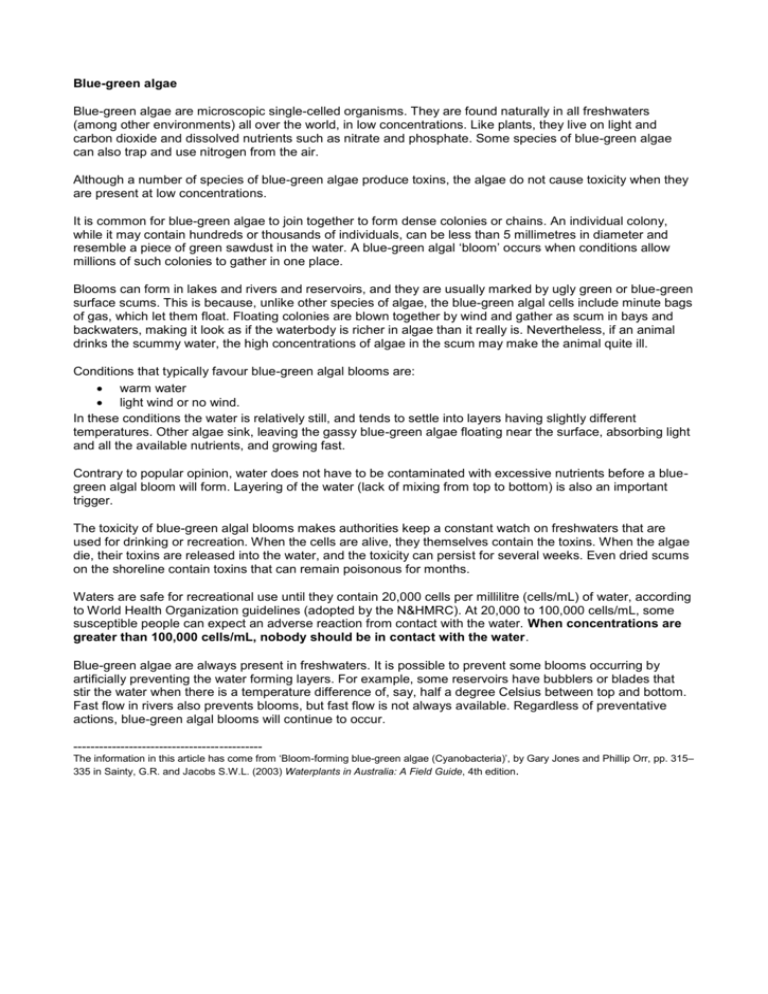
Blue-green algae Blue-green algae are microscopic single-celled organisms. They are found naturally in all freshwaters (among other environments) all over the world, in low concentrations. Like plants, they live on light and carbon dioxide and dissolved nutrients such as nitrate and phosphate. Some species of blue-green algae can also trap and use nitrogen from the air. Although a number of species of blue-green algae produce toxins, the algae do not cause toxicity when they are present at low concentrations. It is common for blue-green algae to join together to form dense colonies or chains. An individual colony, while it may contain hundreds or thousands of individuals, can be less than 5 millimetres in diameter and resemble a piece of green sawdust in the water. A blue-green algal ‘bloom’ occurs when conditions allow millions of such colonies to gather in one place. Blooms can form in lakes and rivers and reservoirs, and they are usually marked by ugly green or blue-green surface scums. This is because, unlike other species of algae, the blue-green algal cells include minute bags of gas, which let them float. Floating colonies are blown together by wind and gather as scum in bays and backwaters, making it look as if the waterbody is richer in algae than it really is. Nevertheless, if an animal drinks the scummy water, the high concentrations of algae in the scum may make the animal quite ill. Conditions that typically favour blue-green algal blooms are: warm water light wind or no wind. In these conditions the water is relatively still, and tends to settle into layers having slightly different temperatures. Other algae sink, leaving the gassy blue-green algae floating near the surface, absorbing light and all the available nutrients, and growing fast. Contrary to popular opinion, water does not have to be contaminated with excessive nutrients before a bluegreen algal bloom will form. Layering of the water (lack of mixing from top to bottom) is also an important trigger. The toxicity of blue-green algal blooms makes authorities keep a constant watch on freshwaters that are used for drinking or recreation. When the cells are alive, they themselves contain the toxins. When the algae die, their toxins are released into the water, and the toxicity can persist for several weeks. Even dried scums on the shoreline contain toxins that can remain poisonous for months. Waters are safe for recreational use until they contain 20,000 cells per millilitre (cells/mL) of water, according to World Health Organization guidelines (adopted by the N&HMRC). At 20,000 to 100,000 cells/mL, some susceptible people can expect an adverse reaction from contact with the water. When concentrations are greater than 100,000 cells/mL, nobody should be in contact with the water. Blue-green algae are always present in freshwaters. It is possible to prevent some blooms occurring by artificially preventing the water forming layers. For example, some reservoirs have bubblers or blades that stir the water when there is a temperature difference of, say, half a degree Celsius between top and bottom. Fast flow in rivers also prevents blooms, but fast flow is not always available. Regardless of preventative actions, blue-green algal blooms will continue to occur. -------------------------------------------The information in this article has come from ‘Bloom-forming blue-green algae (Cyanobacteria)’, by Gary Jones and Phillip Orr, pp. 315– 335 in Sainty, G.R. and Jacobs S.W.L. (2003) Waterplants in Australia: A Field Guide, 4th edition.
